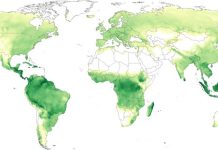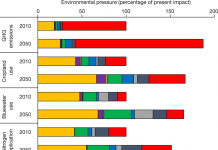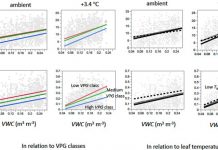【脂肪酸是植物传给菌根真菌主要碳源】Yina Jiang, Wanxiao Wang, Qiujin Xie, et al. Plants transfer lipids to sustain colonization by mutualistic mycorrhizal and parasitic fungi. Science, 2017, Vol. 356, Issue 6343, pp. 1172-1175, DOI: 10.1126/science.aam9970
Abstract
Arbuscular mycorrhizal (AM) fungi facilitate plant uptake of mineral nutrients and draw organic nutrients from the plant. Organic nutrients are thought to be supplied primarily in the form of sugars. Here we show that the AM fungus Rhizophagus irregularis is a fatty acid auxotroph and that fatty acids synthesized in the host plants are transferred to the fungus to sustain mycorrhizal colonization. The transfer is dependent on RAM2 (REQUIRED FOR ARBUSCULAR MYCORRHIZATION 2) and the ATP binding cassette transporter–mediated plant lipid export pathway. We further show that plant fatty acids can be transferred to the pathogenic fungus Golovinomyces cichoracerum and are required for colonization by pathogens. We suggest that the mutualistic mycorrhizal and pathogenic fungi similarly recruit the fatty acid biosynthesis program to facilitate host invasion.
【2006-2014年中国湖泊的总磷浓度】Yindong Tong, Wei Zhang, Xuejun Wang, et al. Decline in Chinese lake phosphorus concentration accompanied by shift in sources since 2006. Nature Geoscience 10, 507–511 (2017) doi:10.1038/ngeo2967
Abstract
Domestic wastewater and agricultural activities are important sources of nutrient pollutants such as phosphorus and nitrogen. Upon reaching freshwater, these nutrients can lead to extensive growth of harmful algae, which results in eutrophication. Many Chinese lakes are subject to such eutrophication, especially in highly polluted areas, and as such, understanding nutrient fluxes to these lakes offers insights into the varying processes governing pollutant fluxes as well as lake water quality. Here we analyse water quality data, recorded between 2006 and 2014 in 862 freshwater lakes in four geographical regions of China, to assess the input of phosphorus from human activity. We find that improvements in sanitation of both rural and urban domestic wastewater have resulted in large-scale declines in lake phosphorus concentrations in the most populated parts of China. In more sparsely populated regions, diffuse sources such as aquaculture and livestock farming offset this decline. Anthropogenic deforestation and soil erosion may also offset decreases in point sources of pollution. In the light of these regional differences, we suggest that a spatially flexible set of policies for water quality control would be beneficial for the future health of Chinese lakes.
【湿地土壤碳对水位下降的响应机制】Yiyun Wang, Hao Wang, Jinsheng He, Xiaojuan Feng. Iron-mediated soil carbon response to water-table decline in an alpine wetland. Nature Communications 8: 15972 (2017) doi:10.1038/ncomms15972
Abstract
The tremendous reservoir of soil organic carbon (SOC) in wetlands is being threatened by water-table decline (WTD) globally. However, the SOC response to WTD remains highly uncertain. Here we examine the under-investigated role of iron (Fe) in mediating soil enzyme activity and lignin stabilization in a mesocosm WTD experiment in an alpine wetland. In contrast to the classic ‘enzyme latch’ theory, phenol oxidative activity is mainly controlled by ferrous iron [Fe(II)] and declines with WTD, leading to an accumulation of dissolvable aromatics and a reduced activity of hydrolytic enzyme. Furthermore, using dithionite to remove Fe oxides, we observe a significant increase of Fe-protected lignin phenols in the air-exposed soils. Fe oxidation hence acts as an ‘iron gate’ against the ‘enzyme latch’ in regulating wetland SOC dynamics under oxygen exposure. This newly recognized mechanism may be key to predicting wetland soil carbon storage with intensified WTD in a changing climate.
【热带泥炭地的地貌和碳通量】Alexander R. Cobba,1, Alison M. Hoytb, Laure Gandoisc,et al. How temporal patterns in rainfall determine the geomorphology and carbon fluxes of tropical peatlands. PNAS, 2017, doi: 10.1073/pnas.1701090114
Abstract
Tropical peatlands now emit hundreds of megatons of carbon dioxide per year because of human disruption of the feedbacks that link peat accumulation and groundwater hydrology. However, no quantitative theory has existed for how patterns of carbon storage and release accompanying growth and subsidence of tropical peatlands are affected by climate and disturbance. Using comprehensive data from a pristine peatland in Brunei Darussalam, we show how rainfall and groundwater flow determine a shape parameter (the Laplacian of the peat surface elevation) that specifies, under a given rainfall regime, the ultimate, stable morphology, and hence carbon storage, of a tropical peatland within a network of rivers or canals. We find that peatlands reach their ultimate shape first at the edges of peat domes where they are bounded by rivers, so that the rate of carbon uptake accompanying their growth is proportional to the area of the still-growing dome interior. We use this model to study how tropical peatland carbon storage and fluxes are controlled by changes in climate, sea level, and drainage networks. We find that fluctuations in net precipitation on timescales from hours to years can reduce long-term peat accumulation. Our mathematical and numerical models can be used to predict long-term effects of changes in temporal rainfall patterns and drainage networks on tropical peatland geomorphology and carbon storage.
【土壤N2O排放】A. N. Kravchenko, E. R. Toosi, A. K. Guber, et al. Hotspots of soil N2O emission enhanced through water absorption by plant residue. Nature Geoscience 10, 496–500 (2017) doi:10.1038/ngeo2963
Abstract
N2O is a highly potent greenhouse gas and arable soils represent its major anthropogenic source. Field-scale assessments and predictions of soil N2O emission remain uncertain and imprecise due to the episodic and microscale nature of microbial N2O production, most of which occurs within very small discrete soil volumes. Such hotspots of N2O production are often associated with decomposing plant residue. Here we quantify physical and hydrological soil characteristics that lead to strikingly accelerated N2O emissions in plant residue-induced hotspots. Results reveal a mechanism for microscale N2O emissions: water absorption by plant residue that creates unique micro-environmental conditions, markedly different from those of the bulk soil. Moisture levels within plant residue exceeded those of bulk soil by 4–10-fold and led to accelerated N2O production via microbial denitrification. The presence of large (∅ >35 μm) pores was a prerequisite for maximized hotspot N2O production and for subsequent diffusion to the atmosphere. Understanding and modelling hotspot microscale physical and hydrologic characteristics is a promising route to predict N2O emissions and thus to develop effective mitigation strategies and estimate global fluxes in a changing environment.
【人类与地球系统同步耦合模型中生物圈的反馈作用】Peter E. Thornton, Katherine Calvin, Andrew D. Jones, et al. Biospheric feedback effects in a synchronously coupled model of human and Earth systems. Nature Climate Change 7, 496–500 (2017) doi:10.1038/nclimate3310
Abstract
Fossil fuel combustion and land-use change are the two largest contributors to industrial-era increases in atmospheric CO 2 concentration1. Projections of these are thus fundamental inputs for coupled Earth system models (ESMs) used to estimate the physical and biological consequences of future climate system forcing2, 3. While historical data sets are available to inform past and current climate analyses4, 5, assessments of future climate change have relied on projections of energy and land use from energy–economic models, constrained by assumptions about future policy, land-use patterns and socio-economic development trajectories6. Here we show that the climatic impacts on land ecosystems drive significant feedbacks in energy, agriculture, land use and carbon cycle projections for the twenty-first century. We find that exposure of human-appropriated land ecosystem productivity to biospheric change results in reductions of land area used for crops; increases in managed forest area and carbon stocks; decreases in global crop prices; and reduction in fossil fuel emissions for a low–mid-range forcing scenario7. The feedbacks between climate-induced biospheric change and human system forcings to the climate system—demonstrated here—are handled inconsistently, or excluded altogether, in the one-way asynchronous coupling of energy–economic models to ESMs used to date1, 8, 9.
【红树林土壤碳储量与流失的全球格局】Trisha B. Atwood, Rod M. Connolly, Hanan Almahasheer, et al. Global patterns in mangrove soil carbon stocks and losses. Nature Climate Change 7, 523–528 (2017) doi:10.1038/nclimate3326
Abstract
Mangrove soils represent a large sink for otherwise rapidly recycled carbon (C). However, widespread deforestation threatens the preservation of this important C stock. It is therefore imperative that global patterns in mangrove soil C stocks and their susceptibility to remineralization are understood. Here, we present patterns in mangrove soil C stocks across hemispheres, latitudes, countries and mangrove community compositions, and estimate potential annual CO2 emissions for countries where mangroves occur. Global potential CO2 emissions from soils as a result of mangrove loss were estimated to be ~7.0 Tg CO2e yr−1. Countries with the highest potential CO2 emissions from soils are Indonesia (3,410 Gg CO2e yr−1) and Malaysia (1,288 Gg CO2e yr−1). The patterns described serve as a baseline by which countries can assess their mangrove soil C stocks and potential emissions from mangrove deforestation.








